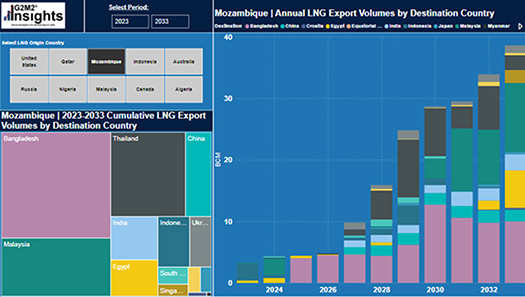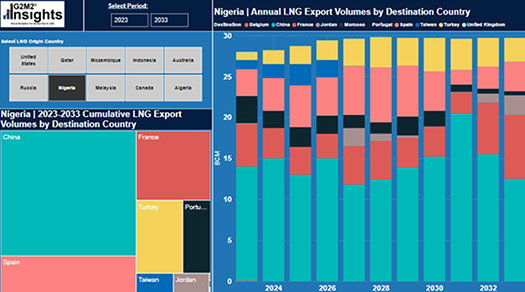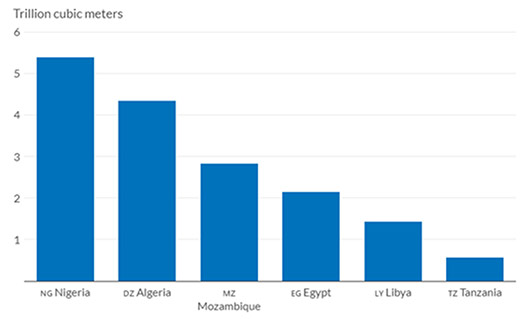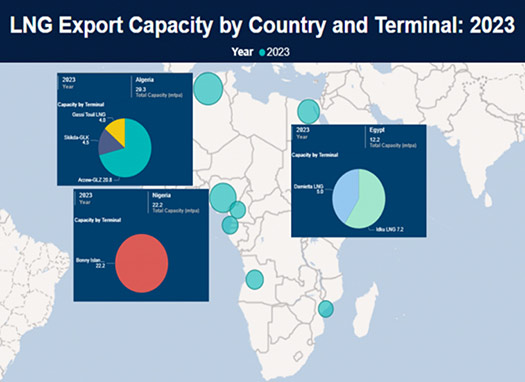December 2023, Vol. 250, No. 12
Features
Natural Gas’ Sleeping Giant Explores Its Possibilities
By Bradley Churchman, Energy Writer, RBAC
(P&GJ) — Africa is a land full of promise, blessed with abundant resources and huge untapped potential in human capital. And when it comes to natural gas, the continent’s gas reserves in 2021 were estimated at 625.6 Tcf, which is nearly equivalent to that of the United States.
If Africa can properly develop their natural resources, they will be able to strengthen their position in the global energy supply chain and provide affordable energy — not just for their people, but also to the entire world. We are seeing glimpses of this already.
According to the Gas Exporting Countries Forum, the demand for energy in Africa is expected to increase 82% by 2050, and natural gas will account for 30% of their energy mix.2
What countries are currently paving the way for increased natural gas production and what will be the state of the industry in Africa a few decades hence?
Africa’s Reserves
Currently, Nigeria has by far the largest gas reserves — at 203 Tcf — which makes up 33% of the 2021 estimate of Africa’s total gas reserves.3 But with Algeria signing new gas exploration deals with Chevron, Exxon4 and TotalEnergies5, they may soon catch up to Nigeria.
Algeria, Nigeria and Egypt currently lead the pack in LNG exports, with the highest export capacity on the continent. Algeria’s export capacity is 29.3 mtpa, Nigeria’s is 22.2 mtpa and Egypt’s is 12.2 mtpa.
According to a report from the African Energy Chamber, “Algeria, Egypt, and Nigeria are expected to drive the majority of the natural gas supply with an average of 80% of the total African gas coming from these three countries.”
Current Projects
There are several big projects in progress or awaiting FID. These include Coral North FLNG, Rovuma LNG, Mozambique LNG and Tanzania LNG, in Southeast Africa. These projects will be instrumental in significantly increasing Africa’s LNG export capacity over the next decade.
Coral North FLNG: This proposed project would be a duplicate of the Coral South FLNG currently in operation. The north facility is expected to commence operations in 2027, and it will be providing a capacity of 3.5 mtpa alongside the 3.5 mtpa already in place at Coral South.7
Rovuma LNG: Rovuma LNG was initially going to be a two-train project, with 7.6 mtpa capacity per train, for 15.2 mtpa combined. However, the design was recently changed to use small modular units. It has become a twelve-train project with 1.5 mtpa capacity per train but a higher total capacity of 18 mtpa.
These smaller trains are becoming more popular for new LNG project proposals. They help mitigate risk for stakeholders, who then don’t have to commit to large projects from the beginning but can instead commit to additions to the project, as demand changes over time.8
Mozambique LNG: This project was proposed to take advantage of the approximately 65 Tcf of natural gas found off the northern coast of Mozambique in 2010. The project reached FID in 2019 but stalled due to concerns of security and stability within the area.
However, TotalEnergies recently announced that they were in the process of restarting construction.9 The project was originally going to be delivering its first cargo in 2024, and it was going have the capacity to export 43 mtpa.10
Tanzania LNG: While the three projects described above are all located within Mozambique, this last project is to be sited just north of Mozambique, in Tanzania. The project was initially proposed in 2016 and would provide 10 mtpa worth of capacity, but negotiations have been slow.
However, recently Equinor, Shell and Exxon reached an agreement with the Tanzanian Government on a regulatory framework and how the LNG produced at this facility will be shared.
“We are happy it is a big step toward the implementation of the project, although we have a lot to do,” said the acting director of Tanzania’s Petroleum Upstream Regulatory Authority, Charles Sangweni. “If everything goes well as planned, I am confident that the final investment decision will be reached in 2025.”11
Africa’s LNG Flow
The top African LNG exporters over the next 10 years are forecast to be Mozambique, Algeria and Nigeria. Because of history and geography, each of these countries are expected to supply its LNG to a different set of destination countries.
Our outlook shows that the top three destinations for Mozambique LNG over the next 10 years will be Bangladesh (66.8 Bcm), Malaysia (36.7 Bcm) and Thailand (36.3 Bcm).12
Nigeria’s top three LNG destinations will be China (158.8 Bcm), Spain (49.0 Bcm) and France (48.5 Bcm).
Algeria’s top three LNG destinations will be Italy (155.8 Bcm), Turkey (26.7 Bcm) and Egypt (15.7 Bcm).
Ukraine was also going to be an importer of Algerian LNG, had their planned LNG import terminal begun operation. The terminal was going to consist of both an FSRU and a land-based facility for 7.3 mtpa combined.
This project would have helped Ukraine move away from being reliant on imports of Russian gas; however, the project was never able to get off the ground. It was supposed to start construction in 2012 and be in operation by 2018.13
However, the project was delayed for years, due to a lack of sufficient investment. Interest was renewed again in 2017, when Frontera Resources signed a new agreement with Naftogaz to resume construction, but there have been no new updates on the project since.14 The graph below shows what Algeria’s cumulative LNG exports would be, if Ukraine’s LNG terminal does come online by 2025.

Shaping Africa’s Future
Although the African continent has grown — with a GDP 4.5 times larger than that of 20 years ago — it still has much progress to make. This includes high levels of extreme poverty in the very countries expected to supply large volumes of LNG to the world over the next several decades: Nigeria (11.9%), Tanzania (4.5%) and Mozambique (3.5%).15
While the development of natural gas resources within the continent won’t immediately fix these issues, it will contribute to eventually solving them.
The secretary general of the East Mediterranean Gas Forum stated at a recent energy conference that, “Africa needs to have better living standards, and at the same time, several African countries during the last few years have discovered a lot of gas, and they need to develop this gas to have better lives for their people and also for industrialization.”16
This can be accomplished through the construction of domestic infrastructure such as pipelines, gas-fired power plants and liquefied petroleum gas (LPG) supply chains, to meet the needs of their people. In addition, LNG export projects can help to secure sources of revenue, which can be used to address economic challenges that have stifled development in the past. Even the transportation sector in Africa would benefit from increased investment in natural gas. Vehicles that use compressed natural gas (CNG) have been steadily increasing in number over the last few years, primarily in Nigeria, Egypt, Tanzania and Kenya.17
Natural gas has been steadily increasing its presence in Africa’s energy mix over the last twenty years. It will likely continue its growth, as Africa becomes more industrialized and the availability of reliable electricity becomes more common.

In 2021, only about half of the population of Sub-Saharan Africa had access to electricity.18 Natural gas will likely continue to increase its presence in Africa’s energy mix, as Africa becomes more industrialized and reliable electricity becomes more common and accessible to residents of the continent. The capital saved by investing in and utilizing their domestic resources will help spur economic growth for the future.
Some wish for Africa to move away from further integration of fossil fuels into their economies and instead look toward renewable energy, such as solar power.
However, energy leaders in Africa are of a different view, such as African Development Bank President Akinwumi Adesina, who said, “Africa must have natural gas to complement its renewable energy.”
Many other leaders agree that, to meet the energy needs of a growing and industrializing Africa, natural gas will be needed to provide reliable and affordable energy, as well as better energy access for all.20
Recently, Adesina further said at the Africa Climate Summit 2023, “We must make sure we achieve universal energy access, optimizing and maximizing the potential that Africa has, including natural gas, which is a great part of the energy mix.”21
(Editor’s note: The article first appeared in the September issue of the RBAC Inc. Newsletter. https://rbac.com/rbac-newsletter-2023-issue-10/. RBAC is a provider of natural gas market modeling.)







Comments